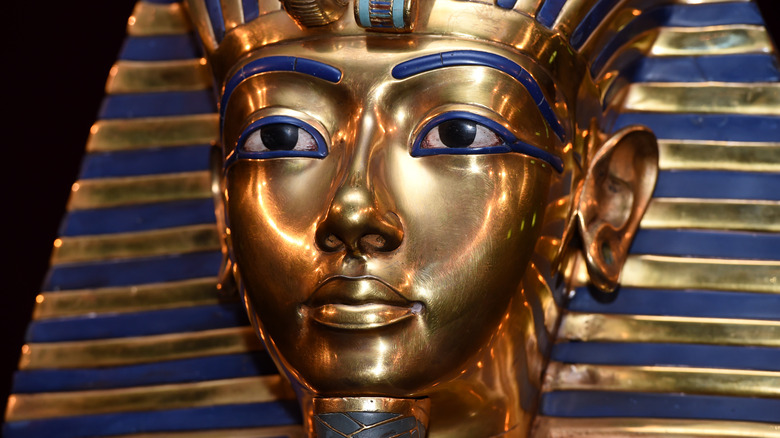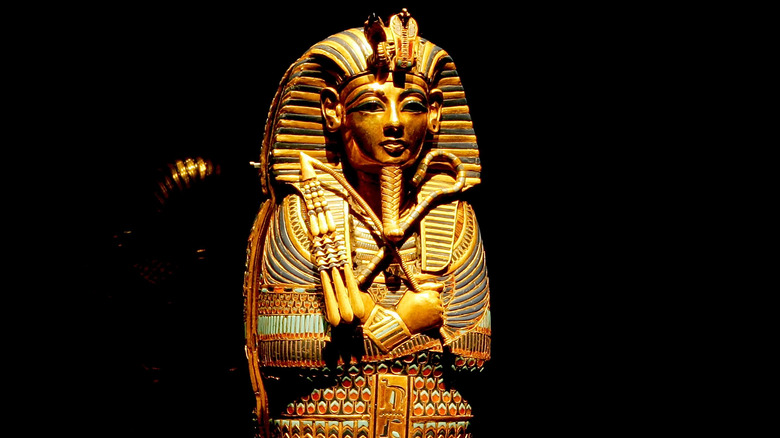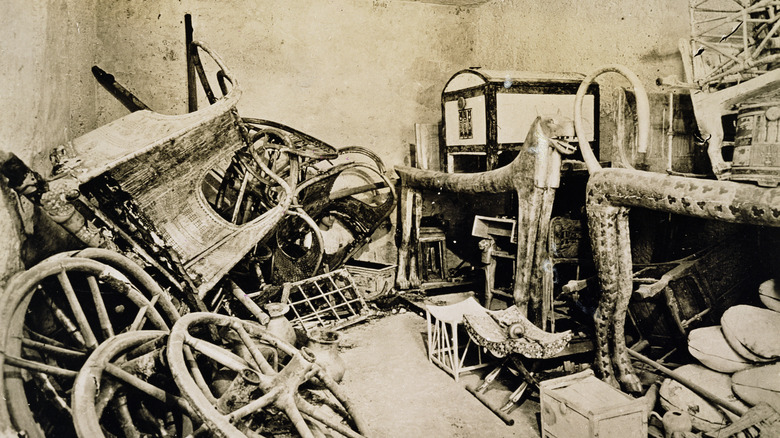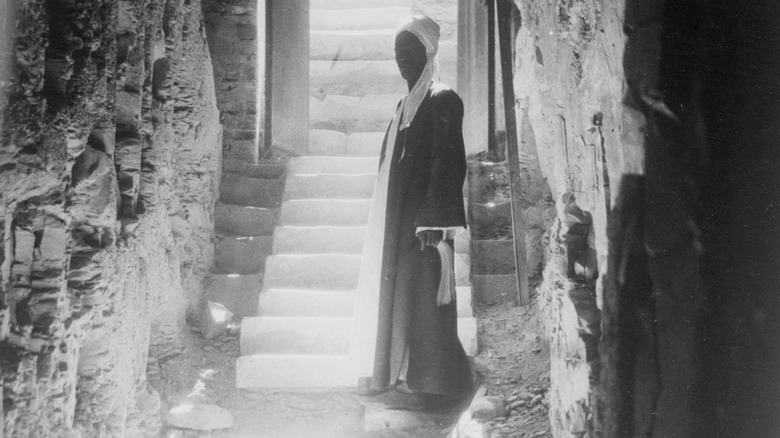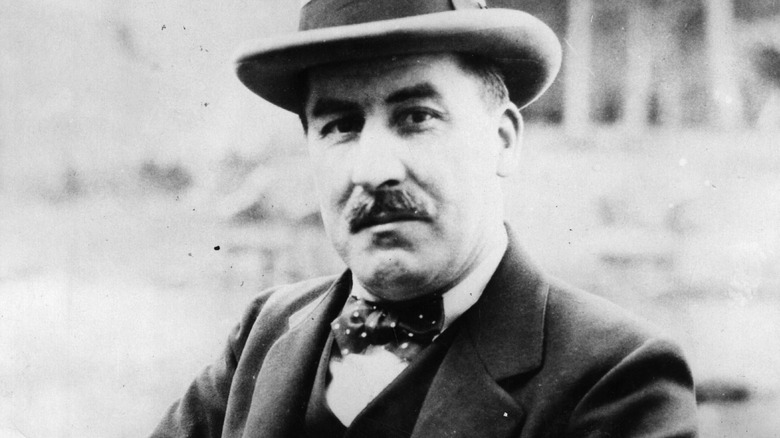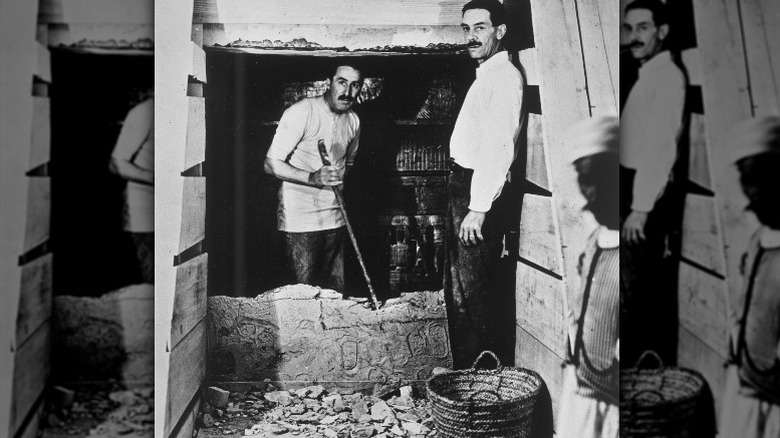A 1934 Letter Revealed What We Always Suspected About King Tut's Treasure
The life of King Tut and his tomb have long been the stuff of legend. First discovered in 1922 by English archaeologist Howard Carter, an alleged curse is even said to have afflicted those who entered the final resting place of the Egyptian pharaoh (via History). Though many artifacts recovered from King Tut's tomb wound up in museums where they remain to this day, there have been persistent allegations that those early explorers, including Carter, could have kept some of those priceless Ancient Egyptian relics for themselves. Thanks to the recently revealed contents of a 1934 letter addressed to Carter, we may now know the truth.
What's also notable is that evidence that Carter was less than honest in his reporting of when, what, and how much was taken from Tut's tomb before the official unsealing comes at a time when authorities all over the world have reconsidered whether ancient artifacts currently on display in museums — and gathered during periods of colonization — should be repatriated to the people and places from where those objects originated, as The New York Times explains.
Who was King Tutankhamen?
Often referred to as the "Boy King," Tutankhamun ruled Egypt for about a decade before his death at the age of 19 in 1324 B.C., per History. Through genetic testing, we now know that Tutankhamun was the grandson of Egyptian pharaoh Amenhotep III and likely the son of the pharaoh Akhenaten. Beyond the reversal of religious reforms moving Egypt away from a polytheistic society, Tut's time on Egypt's throne was unremarkable and largely forgotten before British archaeologist Howard Carter discovered his tomb in the 1920s. In that tomb, Tut's mummified body was found, offering unparalleled insight into the life of the young Egyptian ruler.
Because of this, much has been learned about what Tut's short life was like, such as how he died. As reported by The New York Times, after an X-ray in 1968 revealed a hole in the back of Tut's skull, some speculated the young pharaoh was assassinated. Instead, per History, it's now believed Tut's death likely resulted from complications related to a broken leg, which were revealed by CT scans taken in 1995. Speaking to the Times, Dr. Zahi Hawass, secretary general of the Supreme Council of Antiquities in Cairo (in 2005), agreed with the theory about Tut's leg — rather than a murder plot.
After centuries of relative obscurity, when Tut's tomb was uncovered and the artifacts found were put on display, Tut became something of an international celebrity 3,000 years after his death. That interest ushered in a period of intense fascination toward Ancient Egypt, which endures to this day.
King Tut's tomb was the best-preserved resting place of a pharaoh so far discovered
Part of what fascinated the public so much about the discovery of King Tut's tomb was how well it was preserved. As The Guardian notes, it was tradition to entomb a pharaoh with any number of priceless artifacts, many of which were made from solid gold, as well as countless jewels and amulets. Much of what was included in an Ancient Egyptian pharaoh's tomb played some part in the afterlife. In the mummification process, internal organs were removed from the body and stored alongside the mummified person in so-called canopic jars. The heart was left intact, though, as the Egyptians believed it would be weighed in the afterlife as a measure of how well the pharaoh lived while they were alive.
What explorers found in Tut's tomb was a solid gold portrait mask weighing some 24 pounds, three gold coffins, and thousands of other artifacts from antiquity. such as chariots and articles of clothing from the period, among other examples (per History). Once officially opened in 1923, Howard Carter and his team spent a decade cataloging and clearing out what they found. Over the millennia, the entrance to Tut's tomb was obscured by debris, and its location lost to history. That fact contributed to the five years it took for Carter and his financial backer, Lord Carnarvon, to rediscover its location. At the time that Carter's achievement was announced, he also claimed the tomb was raided in centuries past by grave robbers and for that reason, some relics might be missing.
Where did artifacts recovered from King Tut's tomb end up?
In 1923, alongside Egyptian officials, King Tut's tomb was officially opened a full year after the discovery was announced. According to History, in the early stages, three of the four chambers of the tomb were explored, all of which seemed as if those who had laid Tut in his final resting place had just left. After Carter and his team cataloged and cleared out the relics they found entombed with Tut, the countless priceless discoveries were then transported to the Egyptian Museum in Cairo, where they were put on permanent display in the touring "Treasures of Tutankhamun" exhibit.
Since then, millions have seen these objects from an ancient time, both in Egypt and around the world. In addition to the Egyptian Museum in Cairo, Archaeology Travel reports a chariot from Tut's tomb was also put on display at the Egyptian National Military Museum. As of 2018, all the artifacts discovered with Tut are now housed at the Grand Egyptian Museum (GEM) near the Pyramids of Giza, according to Smithsonian Magazine. Today, Tut's mummified body can be seen in a climate-controlled enclosure on display in a chamber at the Valley of the Kings, near where Tut's tomb was first discovered (per History).
Carter was suspected of taking artifacts for himself
From the start, there was suspicion that Howard Carter and his team opened Tut's tomb on their own before the official unveiling in 1923 under the careful watch of Egyptian officials. The theory was that Carter may have unsealed the tomb and then resealed it for the formal unveiling. For this reason, some believe Carter and others may have taken priceless objects for themselves, only to blame what was missing on grave robbers from antiquity, a version of events that was almost immediately cast in doubt. In 1947, for example, an employee of Carter's alleged the English archaeologist had indeed tampered with the tomb before 1923 and taken objects for himself, but there was no proof, as The Guardian notes.
As Bob Brier, a Long Island University Egyptologist, told The Observer (via The Guardian), at the time the excavation of King Tut's tomb took place, even the Egyptian government suspected Carter. Alongside other evidence, many such artifacts from the tomb of King Tut showed up in the antiquities market after Carter and the other explorers from the excavation had died. "It's been known that Carter somehow had items, and people have suspected that he might have helped himself," Brier explained.
And though Carter never admitted surreptitiously taking invaluable objects from Egyptian history, he also never denied it. What is known is that Carter was prevented from entering Tut's tomb by the Egyptian government. "There was a lot of bad feeling, and they thought he was stealing things," Brier said.
Carter allegedly stole an amulet
Now, proof of Howard Carter's guilt in lifting some priceless artifacts from King Tut's tomb has been revealed in a previously unpublished 1934 letter from an antiquities expert who was part of Carter's team named Sir Alan Gardiner, according to The Guardian. Carter had reportedly given Gardiner an ancient Egyptian amulet that Carter claimed did not originate in the tomb of King Tut. Once Gardiner showed the amulet to an expert named Rex Engelbach at the Egyptian Museum in Cairo, in Engelbach's estimation, it was found to match the mold from which other amulets discovered in Tut's tomb were made.
In the contents of the previously unpublished letter, Gardiner confronted Carter about Engelbach's accusation. The amulet that Carter gave Gardiner "was undoubtedly stolen from the tomb of Tutankhamun," Engelbach had declared. As Gardiner also told Carter in his letter, he did not tell Engelbach where the amulet came from. "I deeply regret having been placed in so awkward a position," Gardiner wrote.
Proof that Carter pilfered artifacts from Tut's tomb will soon be published in its entirety as part of Egyptologist Bob Brier's book "Tutankhamun and the Tomb that Changed the World," which will be published on September 27, 2022 (via Oxford University Press). As Brier told The Guardian, in his opinion, the 1934 letter leaves "no doubt about it," as far as the rumors and suspicions surrounding Carter and Tut's tomb.
